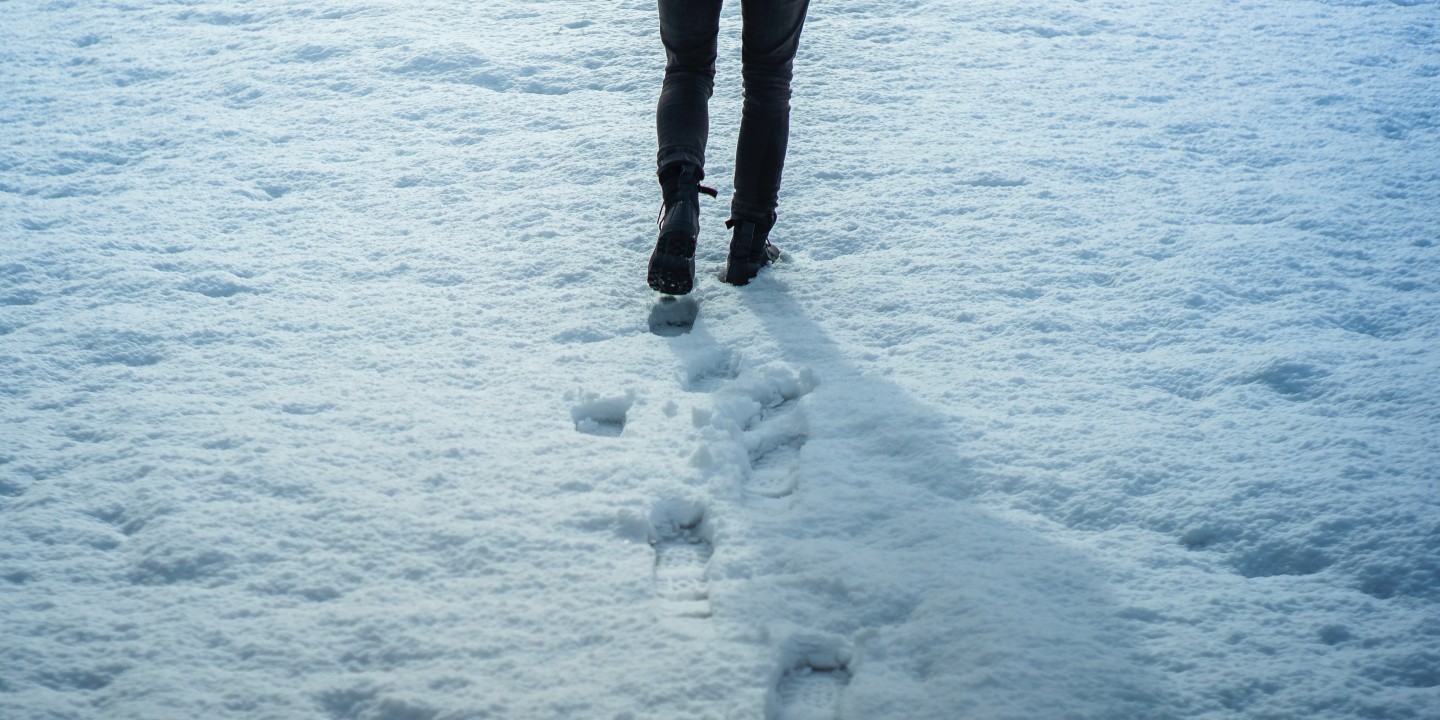
I walk a few miles every day. It began as an effort to improve my health. Recently, I’ve realized that walking has become a spiritual practice as well—and an especially appropriate one this Advent.
Our family decorated for Christmas the day after Thanksgiving. With the living room filled to capacity—statues of snowmen on the piano, Advent wreath on the coffee table, icon of St. Nick staring down from a garland-draped mantle, stockings laid out in front of the fireplace, a tree crowded between two recliners—the whole room felt cozy. It felt safe, the way home should feel.
The next evening, before dinner and prayers and the Saturday-night lighting of the first Advent candle, I took my walk. It was cold outside, so I put on my coat, grabbed my cap with earflaps and a scarf, and headed out the front door. I stepped out of our cocoon of coziness and was shocked by a blast of wintery wind.
As I walked, the wind evaded my defenses. It chapped my cheeks, chilled my ears. It penetrated my pants and coat and the mesh on my sneakers. Though clothes covered my body, still I was exposed.
Throughout these long months of pandemic, many of us have done everything we can not to be exposed. We’ve stayed in if we were able, hunkered down. We’ve tried, in the words of poet May Sarton, to “love safe in the walled city.” For those of us not directly touched by the virus—which is fewer of us each day—we’ve imagined a kind of invulnerability. My own life has become so safe, so routine, that to learn of mounting COVID-19 deaths each day has begun to feel abstract and distant.
Until a nephew gets the virus. Or a college friend loses his father to it. Or it claims a high school classmate, who played the Cowardly Lion to my Tin Man, or a faithful lector in my church. Then I remember that the sense of invulnerability engendered by the privilege of being able to stay home, stay inside, is just that: merely a sense, not the real thing.
Ruther Burrows, a Carmelite sister, has said that in prayer we become “open, exposed, inviting God to do all God wants.” In prayer we set aside our illusions of invulnerability; we lay ourselves bare before the wind of God’s Spirit, before its sometimes gentle caress, its sometimes shocking blast. In prayer we practice what it means to be human.
I’m not sure I know how to do this in prayer, but I’m learning that my walks can help me. They can tutor me in exposure. They can help me taste an undefended openness, if just a little.
Rowan Williams writes that “being a creature is in danger of becoming a lost art.” Reflecting on this line over the years, I’ve read it through the lens of Wendell Berry’s insistence that accepting creaturely finitude requires observing limits: we must stay in our lane, refusing Promethean overreach, or a fate worse than Prometheus’s awaits us. The unavoidable catastrophes being caused by the global climate crisis go some way to proving Berry’s point.
But now I think there’s more to this art than honoring limits. The art of being a creature also means honoring the inherent vulnerability of existing as flesh and blood, a vulnerability present whether we stay in our lane or not. The men and women who are dying of COVID-19 in nursing homes are not exceeding creaturely speed limits, nor are the thousands infected in jails and prisons, nor are the nurses and doctors whose vocations render them more vulnerable than the rest of us. Their suffering is the result of the deadly mixture of innate human vulnerability and a badly mismanaged crisis. Even within our limits, we can’t escape fragility.
Given some health concerns in my family, I’m still not shopping in a grocery store if I don’t have to, and I won’t set foot in a restaurant. We will keep our kids learning online as long as the school district allows and continue to pick up library books curbside. We will try to stay safe, for our own sake and the sake of others.
But I can embrace honoring my human vulnerability this Advent, nonetheless, risking exposure, if to nothing more than wintery cold and roaming delivery trucks, to remind myself that there is no perfectly safe walled city. I can practice the art of creatureliness, however much of a novice I am, by stepping outside each day. By putting one foot in front of the other down the side of a gravelly road, awake, exposed to sun and shade, wind and snow.
On that Saturday walk, as I was heading back up the hill toward our house, the voice of Welsh baritone Bryn Terfel came on my playlist singing Mozart’s Ave Verum Corpus: “Hail, true body, born of the Virgin Mary, who truly suffered, sacrificed on the cross for humanity.”
It’s a eucharistic text, but it fits this season as well. Before the body of Christ ever graced an altar inside a church, that body was laid in a manger as a child—open, exposed, vulnerable. Showing that his body, his life, was the most human of all, that it had become the truest prayer.
As I stepped back into the comforts of home—a dinner of Pakistani beef cooking on the stove, tree lights turned on now that night was falling, holiday music spilling from the kitchen—I knew one thing: that walk, and the ones to follow, would become, somehow, my Advent prayers.




